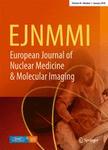版权所有:内蒙古大学图书馆 技术提供:维普资讯• 智图
内蒙古自治区呼和浩特市赛罕区大学西街235号 邮编: 010021

作者机构:Taipei Vet Gen Hosp Natl PET Cyclotron Ctr Taipei Taiwan Natl Yang Ming Univ Inst Biomed Engn Taipei 112 Taiwan
出 版 物:《EUROPEAN JOURNAL OF NUCLEAR MEDICINE AND MOLECULAR IMAGING》 (欧洲核医学与分子成像杂志)
年 卷 期:2004年第31卷第5期
页 面:692-702页
核心收录:
学科分类:1002[医学-临床医学] 1009[医学-特种医学] 10[医学]
主 题:FDG quantitative analysis non-invasive input function CMRGlc
摘 要:A novel statistical method, namely Regression-Estimated Input Function (REIF), is proposed in this study for the purpose of non-invasive estimation of the input function for fluorine-18 2-fluoro-2-deoxy-D-glucose positron emission tomography (FDG-PET) quantitative analysis. We collected 44 patients who had undergone a blood sampling procedure during their FDG-PET scans. First, we generated tissue time-activity curves of the grey matter and the whole brain with a segmentation technique for every subject. Summations of different intervals of these two curves were used as a feature vector, which also included the net injection dose. Multiple linear regression analysis was then applied to find the correlation between the input function and the feature vector. After a simulation study with in vivo data, the data of 29 patients were applied to calculate the regression coefficients, which were then used to estimate the input functions of the other 15 subjects. Comparing the estimated input functions with the corresponding real input functions, the averaged error percentages of the area under the curve and the cerebral metabolic rate of glucose (CMRGlc) were 12.13+/-8.85 and 16.60+/-9.61, respectively. Regression analysis of the CMRGlc values derived from the real and estimated input functions revealed a high correlation (r=0.91). No significant difference was found between the real CMRGlc and that derived from our regression-estimated input function (Student s t test, P0.05). The proposed REIF method demonstrated good abilities for input function and CMRGlc estimation, and represents a reliable replacement for the blood sampling procedures in FDG-PET quantification.